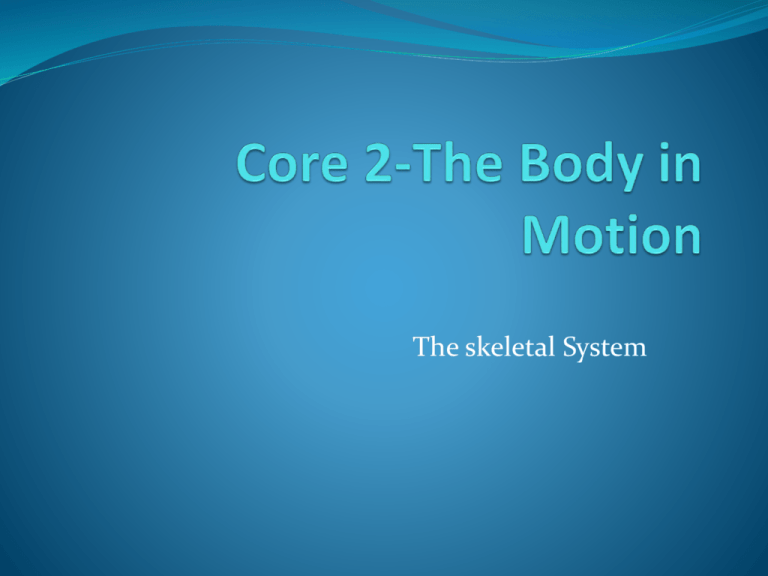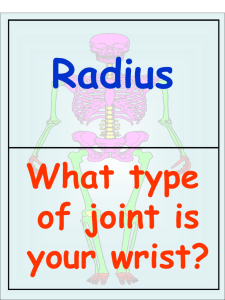Core 2-The Body in Motion
advertisement

The skeletal System Skeletal System An anatomical reference system called directional terms is used to identify the location of bones. The starting point assumes that the body is in the Anatomical position; that is, a reference position where the subject is standing erect, facing front on and with palms facing forward. (Diagram next slide) This enables us to locate a bone in reference to how it is relative to another part of the body. Anatomical Position Transverse Plane Sagittal Plane Frontal (Coronal) Plane Directional Terms Defined Superior-towards the head; for example, the chest is superior to the hips. Inferior- towards the feet; for example, the foot is inferior to the leg. Anterior-towards the front; for example, the nose is anterior to the ear. Posterior-towards the back; for example, the backbone is posterior to the heart. Medial-towards the midline of the body; for example, the big toe is on the medial side of the foot. Lateral-towards the side of the body; for example, the little toe is on the lateral side of the foot. Proximal- towards the body’s mass; for example, the shoulder is proximal to the elbow. Distal- away from the body’s mass; for example, the elbow is distal to the shoulder. Skeletal System Introduction The adult human skeleton has 206 bones. They range in shape and size, a feature that allows them to perform specialised functions. Functions of bones: 1. Protection to vital organs, for example the cranium and ribs. 2. Support framework for the body 3. Movement-site of muscle attachment 4. Storage- minerals, for example calcium 5. Production of Red Blood Cells and White Blood Cells Skeletal System Introduction The skeleton is divided into two (2) major portions: The axial skeleton and the appendicular skeleton. 1. Axial skeleton-consists of the bones of the skull, the vertebral column and the rib cage. Skeletal System Introduction 2. Appendicular skeleton-consists of the bones of the upper and lower limbs and the bony girdles that support them on the body trunk. Pectoral girdle Types of Bone There are five (5) types of bone-long, short, flat, irregular and sesamoid. 1. Long Bones- are hollow, tubular in shape and have along shaft. The ends of long bones form the articulating or connecting surfaces at joints. - these bones can withstand heavy stress and are important in weight bearing. - examples: humerus, femur, radius, tibia, ulna and phalanges. 2. Short Bones- are shaped like a cube and almost equal in length and width. - examples: bones in the wrist (carpals) and ankle bones (tarsals) 3. Flat Bones- generally thin with a layer of spongy bone in their centre. - they are usually broad in shape and have a smooth surface allowing a large area for muscle attachment. -examples: scapula, cranial bones, sternum and ribs Types of Bone 4. Irregular Bones- complex shapes, for example vertebrae 5. Sesamoid Bones- this type of bone is small and found in special tissue called tendons, where there can be more than usual pressure applied. - examples: the patella Overview of skeletal bones Overview of skeletal bones Vertebral Column Joint Types (page 133-Outcomes) Joint Classification Fibrous Cartilaginous Synovial Definition Movement actions allowed Examples Types of synovial joints Type of synovial joint Definition Examples Hinge joint Hinge joints are UNIAXIAL like a door hinge. -movement restricted to flexion and extension • Knee Joint • Elbow Joint Consists of a head that fits into a cup like depression. -Most flexible joint -MULTIAXIAL joint • Shoulder • Hip Convex condyle that fits into a concave surface. -BIAXIAL • Metacarpophalangeal joint (Knuckles) • Flexion, Extension, Abduction, Adduction and Circumduction (Uniaxial) Ball and socket joint (Multiaxial) Condyloid/ellipsoidal joint (Biaxial) Types of synovial joints Type of synovial joint Definition Examples Pivot Joint Consist of a bony pivot projection with a osteoligamentous. • C1 and C2-move head from side to side. • Radius and ulna joint at proximal end. (supination/pronation) -Only example of a nonaxial joint. Articular surfaces are flat and only allow slipping or gliding movements. • Carpals • Tarsals (Uniaxial) Plane/gliding Joint (Non-Axial) Saddle Joint (Biaxial) Each articular surface has • Carpometacarpal joints both a concave and convex of the thumbs. areas that fit together. It is • Flexion, Extension, shaped like a saddle. Abduction, Adduction and Circumduction Function and structure of the knee joint Feature of synovial joints Write notes on features from page 133-134 outcomes textbook. (Ligaments, tendons, synovial fluid and hyaline cartilage).




